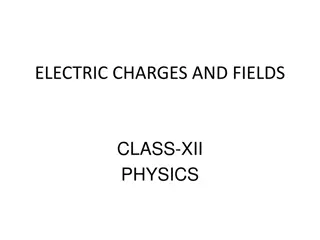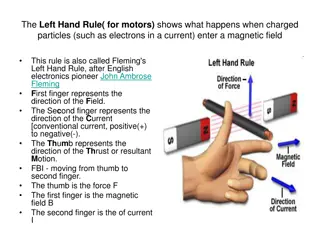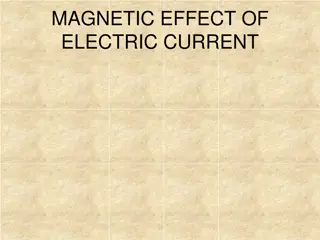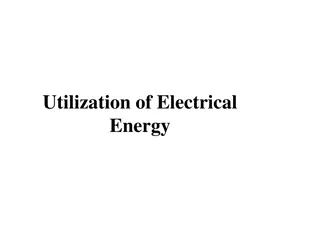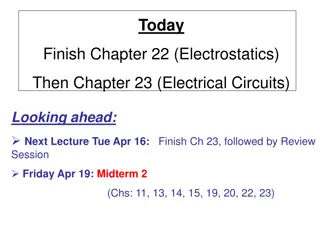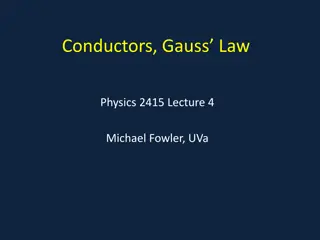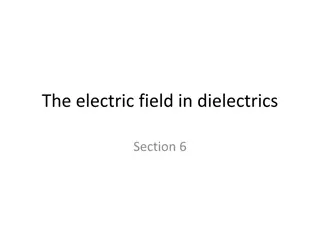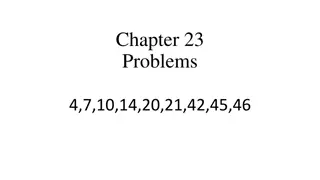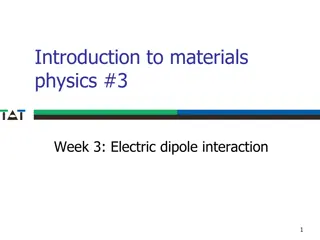Understanding Electric Fields: Fundamentals and Concepts
Electric fields are created by surrounding charges and are represented by vectors indicating the force experienced by a test charge. Electric field lines help visualize the direction and strength of the field, with denser lines indicating stronger fields. The electric field due to a point charge can be calculated using Coulomb's law. Studying electric fields is essential for understanding the behavior of charges in space.
Uploaded on Sep 18, 2024 | 0 Views
Download Presentation

Please find below an Image/Link to download the presentation.
The content on the website is provided AS IS for your information and personal use only. It may not be sold, licensed, or shared on other websites without obtaining consent from the author. Download presentation by click this link. If you encounter any issues during the download, it is possible that the publisher has removed the file from their server.
E N D
Presentation Transcript
CHAPTER 2 ELECTRIC FIELDS Dr. Hind I. Abdulgafour
1-The Electric Field The electric field E that exists at a point is the electrostatic force F experienced by a small test charge q0 placed at that point divided by the charge itself: The electric field is a vector, and its direction is the same as the direction of the force F on a positive test charge. SI Unit of Electric Field: Newton per coulomb (N/C). Important about electric field: It is the surrounding charges that create an electric field at a given point. Any charge q placed at the point with the electric field E will experiences a force, F=qE. For a positive charge, the force points in the same direction as the electric field; for a negative charge, the force points in the opposite direction as the electric field. At a particular point in space, each of the surrounding charges contributes to the net electric field that exists there.
2- The Electric Field Lines The electric charges create an electric field in the space surrounding them. It is useful to have a kind of map that gives the direction and indicates the strength of the field at various places. This can be done by drawing the electric field lines. The properties of the electric field lines Electric field lines (lines of force) are continuous lines whose direction is everywhere that of the electric field
At any point, the tangent direction of the electric line is the direction of electric field. The density of the electric field lines provides information about the magnitude of the field. The lines are closer together where the electric field is stronger, the lines are closer together. The lines are more spread out where the electric field is weaker. The electric field lines always begin on a positive charge and end on a negative charge and do not start or stop in mid space.
The electric charges create an electric field in the space surrounding them. It is useful to have a kind of map that gives the direction and indicates the strength of the field at various places. This can be done by drawing the electric field lines.
3-The Electric Field Due to a Point Charge To find the electric field due to a point charge q (or charged particle) at any point a distance r from the point charge, we put a positive test charge qo at that point. From Coulomb s law, the electrostatic force acting on qo is:
4-The Electric Field Due to an Electric Dipole Two charged particles of magnitude q but of opposite sign, separated by a distance d. We call this configuration an electric dipole. The product qd, which involves the two intrinsic properties q and d of the dipole, is the magnitude p of a vector quantity known as the electric dipole moment of the dipole. The direction of P is taken to be from the negative to the positive end of the dipole.
5-The Electric Field Inside a Conductor: Shielding (1) At equilibrium under electrostatic conditions, any excess charge resides on the surface of a conductor. (2) At equilibrium under electrostatic conditions, the electric field is zero at any point within a conducting material. (3) The electric field just outside the surface of a conductor is perpendicular to the surface at equilibrium under electrostatic conditions.
5-The Electric Field Due to a Line of Charge Up to now we have only considered the electric field of point charges.Now let s look at continuous distributions of charge lines - surfaces - volumes of charge and determine the resulting electric fields. Name Symbol SI Unit q Charge Linear charge density C C/m Surface charge density C/m2 Volume charge density C/m3







